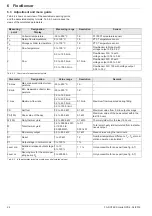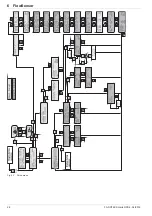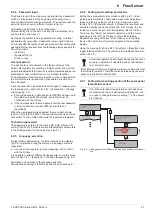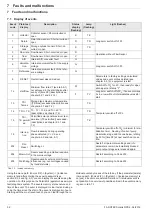
6
x
FlowSensor
FA ROTEX Solaris RPS4 -
04/2016
31
6.4.3 Setting recommendation for the post-heating
via external heat sources or by the electrical
immersion heater, burner blocking contact
For the highest performance potential:
Ɣ
Heat the solar storage tank only infrequently and then only to
a just adequate temperature via the external heat source or
electrical immersion heater.
Ɣ
Restrict the recharging times by means of timer programmes:
a) Determine the optimum times for "normal use" by regular
consumption habits.
b) Enable supplementary heating for 1/2 to 2 hours before
usual usage time depending on the external source.
Ɣ
The charging time should be limited so that the cylinder does
not need to be directly heated after a normal consumption
cycle.
Ɣ
If greater volumes of hot water are used and to maintain
comfortable temperatures during periods of unusual use, set
the temperature in the hot water zone to a sufficiently high
level or enable the heat generator for supplementary heating,
e.g. by switching to a different timer programme.
Setting the storage tank charging temperature
Ɣ
Set the hot water target temperature so that there is adequate
hot water for drawing off (e.g. for one shower) at the lowest
possible setting value. This setting will guarantee the
maximum heating of the hot water by the solar installation for
a certain withdrawal quantity.
Heating by means of an external heat generator
Depending heating requirements (related to the building's insu-
lation standard, outdoor temperature, and desired room temper-
atures) and the installed collector surface, it might be expedient
to disable the external heat generator by fitting a burner inhibit
contact. For this purpose, also if the heater control demands ad-
ditional heat:
Ɣ
Set the operating parameters [P min], [TS min] and [time
VBSK] in such a way that the external heat generator does
not heat (see section 6.3.10),
– if a a minimum heating output is provided by the solar pan-
els or
– the storage cylinder has reached a sufficiently high tem-
perature.
6.4.4 Tips for optimised user behaviour
Hot water needs and user behaviour are highly individual.
The higher the desired storage cylinder temperature is, and the
longer the periods for non-solar charging heating have been ad-
justed, the more will the storage potential for solar heat gener-
ation be limited. Careful consumption behaviour, adapted to the
particular strengths of the solar system minimises the energy
consumption for non-solar charging processes.
Ɣ
Use modern and convenient shower heads with flow rates of
5 - 7 l/min.
Î
The lower flow rate (hot water consumption per minute)
results in a reduced need for supplementary heating, and
there-fore a larger amount of hot water at a higher temper-
ature.
Ɣ
Reduce the consumption times.
Î
Lower energy consumption.
Ɣ
Start filling the bathtub only with hot water.
Î
After the domestic water stored in the solar storage tank
has been drawn off, the hot water outlet temperature
drops slightly and the water is mixed in the bath. In this
way, the storage capacity is used in an optimal manner
with a minimum charging temperature; an adequate
amount of hot water is available.
6.4.5 Domestic water hygiene
If no hot water is used for several days and the storage temper-
ature of the Solaris system does not reach at least 60°C, for hy-
giene reasons (Legionella protection) it is periodically heated up
to above 60°C once or draw-off of the stored hot water (25 l) is
recommended.
The optimum charging temperature depends on per-
sonal needs; frequently a storage cylinder temperature
of 50°C is adequate. An average shower requires about
30 to 50 l of hot water with an outlet temperature of
40°C. The cold water that flows into the storage tank when tak-
ing a shower must be heated in the solar storage tank in a
through-flow heating manner.














































